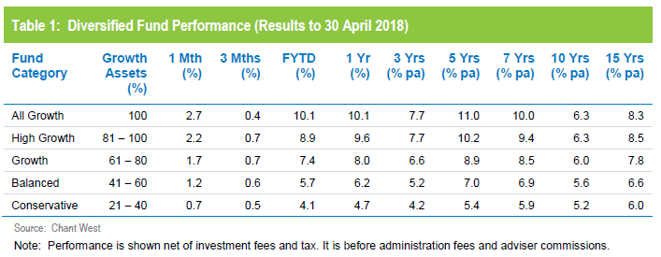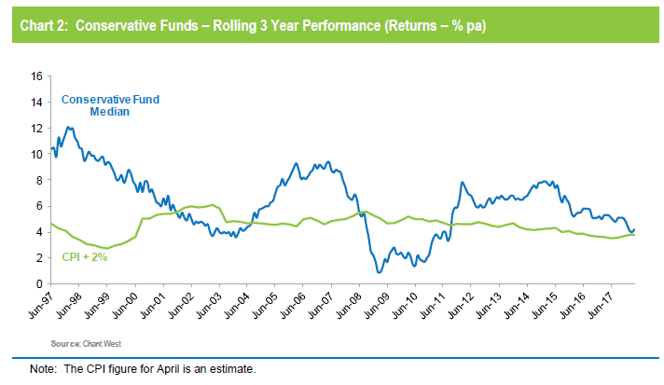After a flat March quarter, super funds had a strong April with the median growth superannuation fund (61 to 80% in growth assets) up 1.7%. This brings the return over the first ten months of the financial year to a healthy 7.4%.
After a flat March quarter, super funds had a strong April with the median growth superannuation fund (61 to 80% in growth assets) up 1.7%. This brings the return over the first ten months of the financial year to a healthy 7.4%.
In April, share markets which are the main drivers of growth fund performance, performed well. Australian shares surged 3.8%. International shares were up 1.9% in hedged terms, but the slight depreciation of the Australian dollar pushed the return in unhedged terms higher to 2.8%. Listed property also advanced with Australian and global REITs up 4.3% and 2.9%, respectively.
Chant West senior investment research manager, Mano Mohankumar says: “With the cumulative return over the first ten months of the 2018 financial year sitting at 7.4% and markets also up in May so far, growth funds appear certain to finish the year in positive territory for the ninth consecutive time. Additionally, funds are on pace to beat the typical long-term return objective which is about 5.5% to 6.5%.
“That’s better than expected and particularly impressive given that we’ve had such a great run over the past eight years with growth funds averaging 9% per annum. Additionally, asset managers have been saying for some time that all asset classes are close to or fully valued and that it’s becoming increasingly difficult to find additional sources of return.
“In April, US shares advanced partly on the back of encouraging macroeconomic data, with GDP ahead of expectations for the March quarter. Additionally, fears over a US-China trade war cooled.
“Share markets in the Euro zone had a good month but the European Central Bank (ECB) kept monetary policy on hold citing subdued inflation. Markets in the UK bounced back strongly in April after a particularly disappointing start to the year. However, uninspiring macroeconomic data released during the month lowered expectations of an interest rate hike.
“Closer to home, the Chinese share market also made gains as trade concerns eased. In Australia, the RBA kept interest rates on hold at 1.5% where it has been since August 2016."
Table 1 compares the median performance for each category in Chant West’s Multi-Manager Survey, ranging from All Growth to Conservative. Over one, three, five, seven and fifteen years, all risk categories have met their typical long-term return objectives, which range from CPI + 2% for Conservative funds to CPI + 5% for All Growth. Even the ten year returns, which have been weighed down longest by the GFC effect, have improved to the point where only the All Growth and High Growth categories are short of their return objectives.

Chart 1 compares the performance since July 1992 – the start of compulsory superannuation – of the Growth category median with the typical return objective for that category (CPI plus 3.5% per annum after investment fees and tax over rolling five year periods). The healthy returns in recent years, and with the GFC period now out of the calculation, have seen the five year performance tracking well above that CPI plus 3.5% target.

Chart 2 compares the performance of the lower risk Conservative category (21 to 40% growth assets) median with its typical objective of CPI plus 2% per annum over rolling three year periods. It shows that, now the GFC years have faded into history, Conservative funds have also been exceeding their performance objectives, although the margin has fallen in recent months due to the lower returns from traditional bonds and cash.

Retail funds edge industry funds in April
Retail funds outperformed industry funds in April, returning 1.8% versus 1.6% but remain behind over the financial year to date, at 7.1% versus 8.1%. Industry funds also continue to hold the advantage over the medium and longer term, ahead by between 0.7% and 1.5% per annum, as shown in Table 2.





